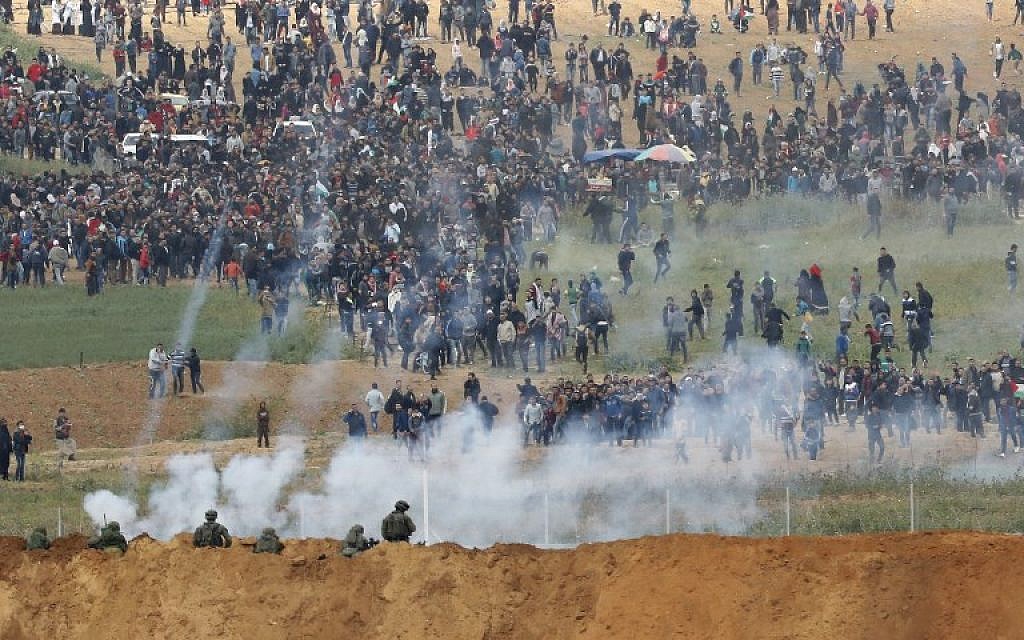IDF attack helicopters hit two positions of the Hamas terror group in the southern Gaza Strip on Monday in response to an explosive device that was carried into Israel by balloons launched from the Palestinian enclave, the army said.
It was Israel’s fourth retaliatory airstrike against the terror group in the past three days.
It came after a bunch of balloons carrying explosives came down between two buildings in the Eshkol Regional Council, the council said in a statement. The bomb exploded but caused neither injuries nor damage.
On Sunday night an Israeli military drone bombed a Hamas position in the northern Gaza Strip in response to a violent riot along the border nearby, according to Palestinian media.
Members of a so-called “confusion unit” held a violent demonstration along the security fence in the northern Gaza Strip, east of Beit Hanoun, burning tires and setting off many explosive devices near the border.
“An Israel Defense Forces aircraft attacked a Hamas post in response to the throwing of explosive devices across the security fence in the northern Gaza Strip,” the army said at the time.
It appeared to be the military’s first time conducting such an attack in response to riots along the security fence itself, rather than to cross-border violence directed toward Israeli civilian communities.
Hours later, the regional council said two more balloons flown from the Strip exploded in the air. It also said Palestinians were taking part in violent protests on the Gaza side of the border and warned residents that further explosions would likely be heard in the area
“The IDF is on the scene and in control,” the council said in a statement.
After halting their activities for several months, the Palestinian “confusion units” recently returned to the Gaza border, holding riots at various locations along the security fence each night in an effort to maintain pressure on Israel by tormenting civilians living nearby and troops serving on the border.
On Saturday evening, the Israeli army said its aircraft fired at targets in the southern Gaza Strip in response to a cluster of balloons attached to an incendiary device that was launched from the Strip toward Israel.
The explosive balloons did not cause any injuries or damage.
The border riots are part of the March of Return protests, which have taken place weekly along the border since last March and have periodically escalated into major flare-ups between the Israeli military and Gaza-based terror groups.
Israel has accused Hamas, the terror organization that rules the Strip, of orchestrating the clashes and using them as cover to breach the border fence and carry out attacks.
Recent weeks have seen a dramatic increase in the level of violence along the Gaza border, with near nightly riots and a return of airborne arson attacks, which had waned in light of a de facto ceasefire agreement between Israel and Hamas at the end of last year.
Despite a dire economic situation, Gaza’s rulers are opting for a measured response to border protest deaths. But a mass protest planned for Land Day on March 30 could lead to war

Fifty-two point one percent.
That is the current unemployment rate in the Gaza Strip. Every second adult is unemployed. Among the young, educated population, the rate is even more striking: over 70%. The numbers are almost incomprehensible.
Gaza’s economy is stuck and has no growth stimuli. Residents may have more hours of electricity per day than in the past — eight — but their future is looking dimmer than ever. If anyone is wondering why we have been seeing another increase over the last two weeks in so-called “popular terrorism” — incendiary balloons, improvised explosives, etc. — the Strip’s economy can supply a sad but sufficient explanation.
And that is just the beginning. At the end of the month Palestinians will be marking “Land Day,” a year since the tactic of mass demonstrations on the border was first implemented. And if until recently it seemed like the Hamas terror group and its leader Yahya Sinwar had an achievement or two to show for it — notably the $15 million monthly cash transfer from Qatar that enabled salary payments to Hamas employees — that has now vanished.
Hamas doesn’t seem to be planning a major escalation of tensions, at least until the end of the month. It is using the weekly Friday protests and other activities as a means of letting off steam. Gazans have been increasingly critical of Hamas over the halt in salary payments and the lack of response to the recent killing of three teenagers by IDF forces during border riots.
Instead of being dragged into an all-out war, Hamas has opted for increasing the daily tensions with Israel. But when the organization speaks about a “million-man march,” it is clear that March 30 will bring something different. And in the Gaza pressure cooker, in which the young generation has no hope, it is likely we will find many of them near the fence, with Hamas’s encouragement.
0 comments:
Post a Comment